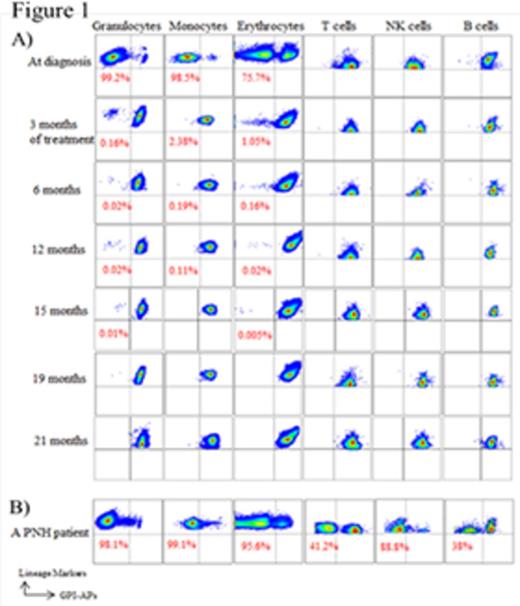Abstract
Background: The clonal expansion of PIGA mutant hematopoietic stem cells (HSCs) can be induced by secondary driver mutations in genes such as HMGA2 and JAK2 in some patients with paroxysmal nocturnal hemoglobinuria (PNH). Theoretically, this type of PNH may be cured by molecular targeted therapy if the therapy is specific for the driver mutations and can eliminate PIGA mutant HSCs that acquired a proliferative advantage. However, this theory has not been proven because of the lack of an appropriate targeted therapy for known driver mutations responsible for clonal expansion of PIGA mutant HSCs. We recently treated a case of PNH complicated by chronic myeloid leukemia (CML) with nilotinib and observed a complete molecular response of CML followed by a complete disappearance of glycosylphosphatidylinositol-anchored protein-deficient (GPI-AP-, PNH-type) cells after 19 months of treatment.
Case report: The patient, a 27-year-old Japanese woman, developed severe anemia with leukocytosis and thrombocytosis in 2013. The laboratory findings on admission were as follows: white blood cell count of 18.7x109/L with 1.7% stab neutrophils, 5.4% segmented neutrophils, 9.3% basophils, 1.3% promyelocytes, 5.0% myelocytes, 3.0% metamyelocytes, 18.0% lymphocytes and 0.7% blasts; hemoglobin (Hb)=6.0 g/dL, platelets=1,000x109/L, 20.0% reticulocytes, total/direct bilirubin=1.9/0.3 mg/dL, LDH=1963 IU/L and haptoglobin <10 mg/dL. A high-sensitivity flow cytometry analysis of the patient's peripheral blood at diagnosis revealed that 99.2% of granulocytes, 75.7% of erythrocytes and 99.3% of monocytes were GPI-AP-, while no T cells, B cells or NK cells had the PNH-phenotype (Figure 1A). This GPI-AP- cell distribution pattern was in sharp contrast to that of a patient with typical PNH who showed various percentages of GPI-AP- cells in all lineages of leukocytes and erythrocytes (Figure 1B). A fluorescent in situ hybridization analysis showed that 98.0% of the patient's granulocytes were BCR-ABL gene-fusion positive. Deep sequencing of leukocytes obtained at diagnosis showed a G279T (Q93H) mutation in exon 4 of the PIGA gene. The patient was diagnosed with PNH complicated by CML in the chronic phase, and was treated with nilotinib at 400 mg/day. The percentage of GPI-AP- cells rapidly decreased in response to nilotinib, with 0.02% GPI-AP- granulocytes after six months of nilotinib therapy when the patient's BCR-ABL mRNA decreased to 0.007%. BCR-ABL mRNA decreased to less than 0.0035% 15 months after therapy; however, small populations of GPI-AP- granulocytes (0.01%) and erythrocytes (0.005%) were still detected at this time (Figure 1A). GPI-AP- cells became undetectable after 19 months of nilotinib therapy, suggesting that the BCR/ABL fusion occurred in a subclone of a PIGA mutant hematopoietic progenitor cell (HPC). The patient was continuing nilotinib as of August 2015 without any signs of an increase in the BCR-ABL mRNA copy number.
Conclusions: This case indicates the BCR-ABL fusion can be a driver mutation capable of inducing the clonal expansion of PIGA mutant clones. More importantly, the origin of PNH in our case proved to be a minor HPC clone with a PIGA mutation, suggesting that PNH can be derived from an HPC with a limited life span only if a potent second hit occurs in the PIGA mutant HPC. The identification of driver mutations in patients with PNH may therefore lead to the development of targeted therapy capable of curing PNH.
No relevant conflicts of interest to declare.
Author notes
Asterisk with author names denotes non-ASH members.


